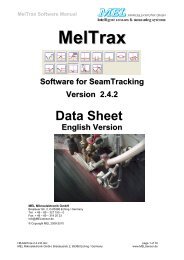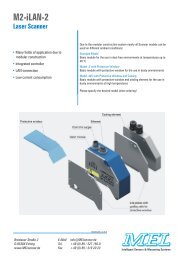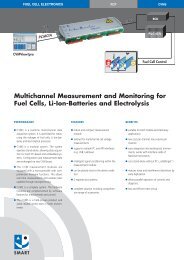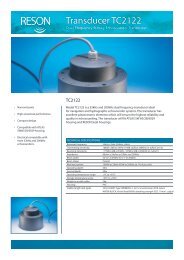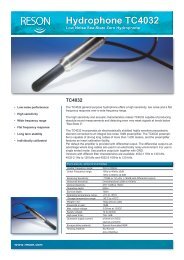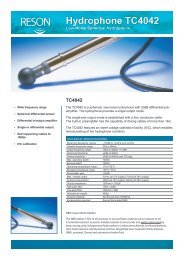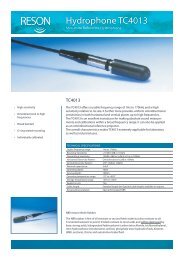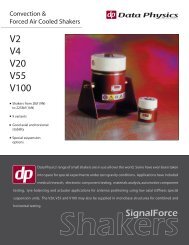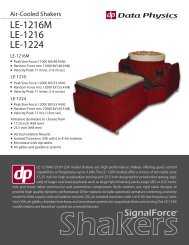Hydrophone TC4014 - Teledyne Reson
Hydrophone TC4014 - Teledyne Reson
Hydrophone TC4014 - Teledyne Reson
Create successful ePaper yourself
Turn your PDF publications into a flip-book with our unique Google optimized e-Paper software.
<strong>Hydrophone</strong> <strong>TC4014</strong><br />
Broad Band Spherical <strong>Hydrophone</strong><br />
<strong>TC4014</strong>-5<br />
• Wide usable frequency range<br />
• Omnidirectional in all planes<br />
• Built-in low noise preamplifier<br />
• Long term stability<br />
• Individually calibrated<br />
• Available with differential<br />
output<br />
The <strong>TC4014</strong>-5 broad band spherical hydrophone offers a very wide usable frequency<br />
range with excellent omnidirectional characteristics in all planes. The overall receiving<br />
characteristics makes the <strong>TC4014</strong>-5 an ideal transducer for making absolute underwater<br />
sound measurements up to 480kHz. The wide frequency range also makes<br />
the <strong>TC4014</strong>-5 perfect for calibration purposes, particularly in higher frequencies.<br />
The <strong>TC4014</strong>-5 incorporates a low-noise 26dB preamplifier providing signal conditioning<br />
for transmission through long underwater cables.<br />
The <strong>TC4014</strong>-5 features an insert calibration facility, which allows for a reliable test of<br />
the hydrophone.<br />
The sensor element is permanently encapsulated in Special formulated NBR to<br />
ensure long term reliability. The rubber has been specially compounded to ensure<br />
acoustic impedance close to that of water. The hydrophone and connector housing<br />
are made of corrosion resistant aluminum-bronze.<br />
<strong>TC4014</strong>-5 has differential output. The differential output is an advantage where long<br />
cables are used in an electrically noisy environment.<br />
TECHNICAL SPECIFICATIONS<br />
Usable Frequency range: 15Hz to 480kHz<br />
Linear Frequency range: 30Hz to 100kHz ±2dB 25Hz to 250kHz ±3dB<br />
Receiving Sensitivity: Single ended: -186dB ±3dB re 1V/µPa<br />
Diff. out: -180dB ±3dB re 1V/µPa)<br />
Horizontal directivity:<br />
Omnidirectional ±2dB at 100kHz<br />
Vertical directivity:<br />
270° ±2dB at 100kHz<br />
Operating depth:<br />
900m<br />
Survival depth:<br />
1200m<br />
Operating temperature range: -2°C to +55°C<br />
Storage temperature range: -40°C to +80°C<br />
Weight in (air):<br />
650g without cable<br />
Max. output voltage:<br />
≥2.8Vrms (at 12VDC)<br />
Preamplifier gain:<br />
26dB<br />
Supply voltage:<br />
12 to 24VDC<br />
High pass filter:<br />
15Hz -3dB<br />
Calibration path attenuation: at 10kHz 14dB<br />
Current consumption:<br />
<strong>Hydrophone</strong> <strong>TC4014</strong><br />
Broad Band Spherical <strong>Hydrophone</strong><br />
NBR means Nitrile Rubber<br />
The NBR rubber is first of all resistant to sea and fresh water but also resistant to oil. It is limited resistant to petrol, limited resistant<br />
to most acids and will be destroyed by base, strong acids, halogenated hydrocarbons (carbon tetrachloride, trichloroethylene), nitro<br />
hydrocarbons (nitrobenzene, aniline), phosphate ester hydraulic fluids, Ketones (MEK, acetone), Ozone and automotive brake fluid.<br />
Documentation:<br />
Horizontal directivity: At 100, 200, 300 kHz<br />
Receiving sensitivity: At 5 kHz to 500 kHz<br />
Vertical directivity: At 100, 200, 300 kHz<br />
Sensitivity at ref.: frequencies: 250 Hz<br />
Horizontal <strong>TC4014</strong>-1 directivity Receiving patternDirectional Response<br />
0 dB<br />
-3 dB<br />
-10 dB<br />
-20 dB<br />
-30 dB<br />
-90 ō 60 o -30 o 0 o 30 o 60 o 90 o<br />
-40 dB<br />
-170<br />
-175<br />
-180<br />
-185<br />
-190<br />
-195<br />
Receiving Sensitivity [dB re 1V/µPa @ 1m]<br />
Receiving Response [dB re 1V/µPa @ 1m]<br />
-200<br />
-120 o<br />
-150 o<br />
-180 o<br />
150 o<br />
120 o<br />
100kHz<br />
200kHz<br />
300kHz<br />
-205<br />
-210<br />
6 8 10 20 40 60 80 100 200 400<br />
Frequency [kHz]<br />
<strong>TC4014</strong>-5<br />
<strong>TC4014</strong>-1<br />
<strong>TC4014</strong>-1 Vertical directivity Receiving patternDirectional Response<br />
0 dB<br />
-3 dB<br />
-10 dB<br />
-20 dB<br />
-30 dB<br />
-90 ō 60 o -30 o 0 o 30 o 60 o 90 o<br />
-40 dB<br />
dB re 1 µPa / √ Hz<br />
Typical equivalent Equivalent noise noise pressure spectrumcurve<br />
80<br />
70<br />
60<br />
50<br />
40<br />
30<br />
20<br />
10<br />
0<br />
Seastate zero<br />
<strong>TC4014</strong><br />
Wenz's minimum<br />
Thermal water noise<br />
10 100 1000 10000 100000<br />
Frequency [Hz]<br />
-120 o<br />
120 o<br />
Valid for all versions of <strong>TC4014</strong><br />
-150 o<br />
-180 o<br />
150 o<br />
100kHz<br />
200kHz<br />
300kHz<br />
www.reson.com
<strong>Hydrophone</strong> <strong>TC4014</strong><br />
Broad Band Spherical <strong>Hydrophone</strong><br />
Accessories for <strong>TC4014</strong>-5<br />
TL8140<br />
TL8142<br />
Electrical Diagram for <strong>TC4014</strong>-5<br />
www.reson.com
<strong>Hydrophone</strong> <strong>TC4014</strong><br />
Broad Band Spherical <strong>Hydrophone</strong><br />
Insert voltage calibration<br />
The <strong>TC4014</strong> preamplifier contains an insert calibration circuit. This allows for electrical calibration of the hydrophone. The calibration<br />
method is not an absolute calibration but, it provides a reliable method for testing of the hydrophone, especially for hydrophones<br />
in fixed remote installations. The insert sine signal simulates the output signal from the sensor element.<br />
To perform an insert calibration, use an appropriate function generator. The applied calibration signal must not exceed 10 Vrms. A<br />
higher voltage may damage the calibration resistor. 2 Vrms will be appropriate for insert calibration. The attenuation of the calibration<br />
signal is 14dB@10kHz for short cables.<br />
Apply the signal to the calibrate input, connector contact 4. = green wire of cable. Connect generator ground to sine generator<br />
ground, and measure the signal on hydrophone output.<br />
Outline Dimensions<br />
RESON reserves the right to change specifications without notice. © 2011 RESON A/S<br />
For Acoustical Measurement Accuracy please refer to www.reson.com or contact sales.<br />
RESON A/S<br />
Denmark<br />
Tel: +45 4738 0022<br />
E-mail: reson@reson.com<br />
RESON GmbH<br />
Germany<br />
Tel: +49 431 720 7180<br />
E-mail: reson@reson-gmbh.de<br />
RESON Inc.<br />
USA<br />
Tel: +1 805 964-6260<br />
E-mail: sales@reson.com<br />
RESON B.V.<br />
The Netherlands<br />
Tel: +31 (0) 10 245 1500<br />
E-mail: info@reson.nl<br />
www.reson.com<br />
RESON Offshore Ltd.<br />
United Kingdom<br />
Tel: +44 1224 709 900<br />
E-mail: sales@reson.co.uk<br />
RESON (Pte.) Ltd.<br />
Singapore<br />
Tel: +65 6725 9851<br />
E-mail: sales@reson.com<br />
Version: B109 091221 / A4



